GLBenchmark 2.5 Performance on Modern Android Smartphones & Tablets
by Anand Lal Shimpi & Brian Klug on July 31, 2012 10:00 AM EST- Posted in
- Smartphones
- GLBenchmark
- Mobile
- Tablets
- SoCs
Smartphones
There's a bit more variety in our smartphone GLBenchmark 2.5 results. Here we have two Samsung SoCs paired with the ARM Mali-400 MP4 GPU: the original dual-core Exynos 4210 as well as the Exynos 4 Quad (4412) from the international Galaxy S 3. Tegra 3 makes an appearance, as does TI's OMAP 4460. The latter shows up in two configurations, one with the SGX 540 running at full 384MHz clocks in the Huawei Ascend P1 and another with the SGX 540 running at 307MHz in the Galaxy Nexus (CPU clocks are 20% lower as well in the GN). Finally we have Qualcomm's dual-core Snapdragon S4 with its Adreno 225 GPU in the HTC One X and the US Galaxy S 3.
The Mali-400/MP4 continues to be the fill rate king, outpacing NVIDIA's Tegra 3 by over 50%. The advantage doesn't extend however to the triangle tests, expressing a key weakness in the Mali-400/MP4 architecture: significantly ratchet up polygon counts and performance falls flat. Remember that Mali-400 isn't a unified shader architecture, and explicitly features more pixel shader hardware than vertex shader hardware. Qualcomm inches ahead in the vertex and fragment lit triangle throughput tests, although NVIDIA remains quite competitive. Both the Mali-400 and SGX 540 don't do well here.
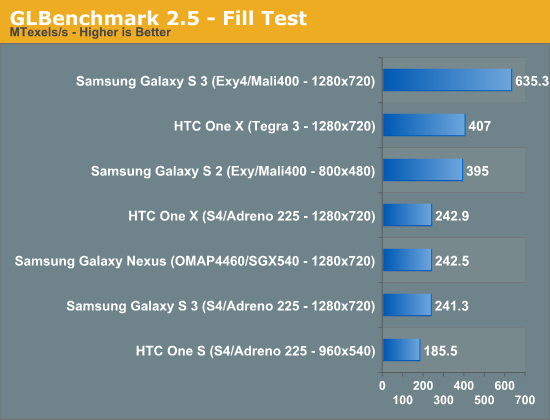
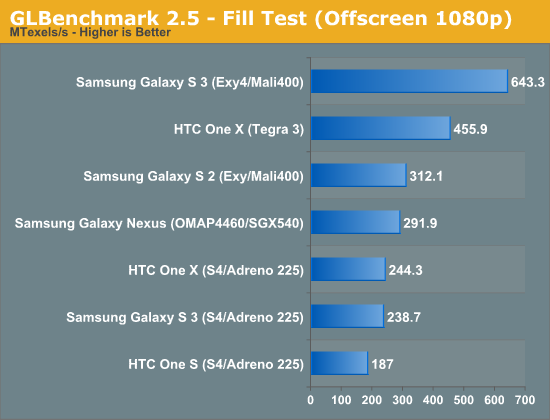
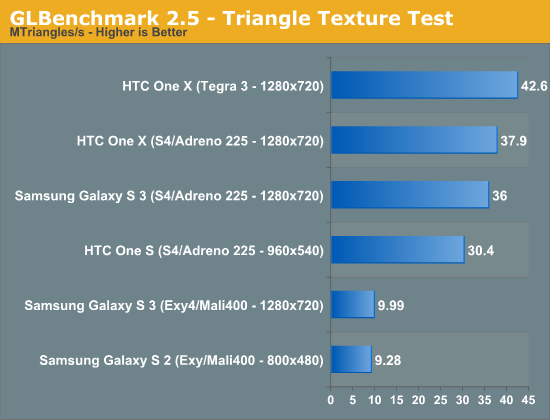
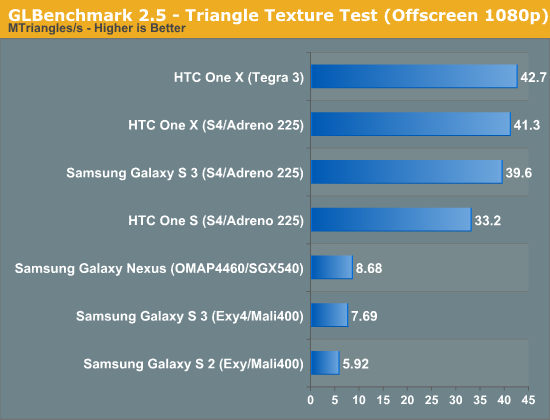
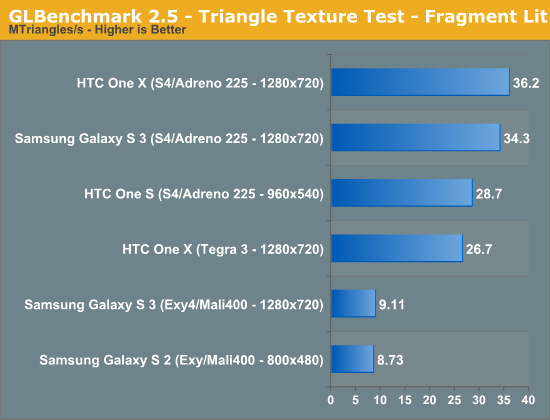
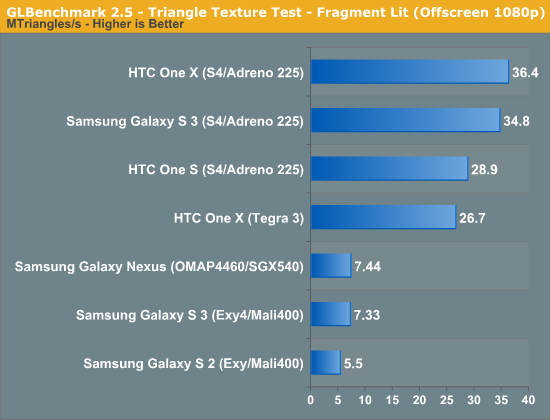
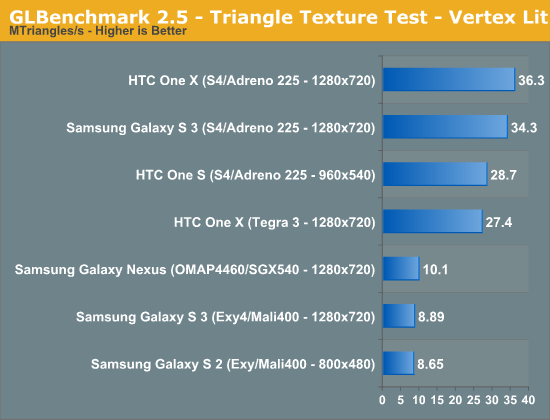

Egypt HD doesn't look quite as bad in the smartphone results, but that's mostly because we have some resolutions at 960 x 540 or below. Even then, none of these devices can break 30 fps. Remove vsync and crank up the resolution to 1080p and we hit the same ~13 fps cap as we did on the tablets.


The classic results once again show us that for lighter workloads, all of the modern GPUs (Mali 400, Adreno 225, Tegra 3) are sufficient. At lower polygon counts, even the latest Mali 400 can hit nearly 60 fps at 1080p.
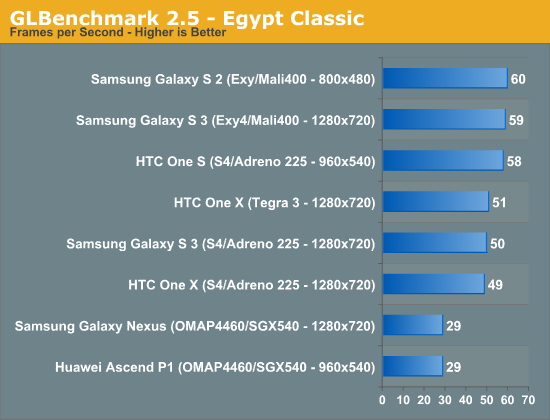
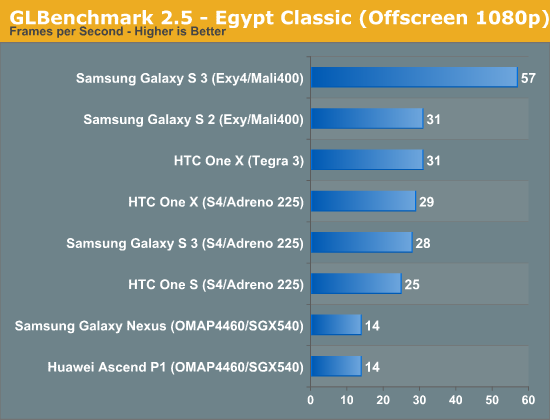










47 Comments
View All Comments
Mike1111 - Tuesday, July 31, 2012 - link
"A5X roughly triples the Fill Test of the Tegra 3. It also gets about 50 fps on the Offscreen test in Egypt HD."I wish. But I only see 24fps in the Egypt HD 1080p offscreen?!
pcinyourhand - Tuesday, July 31, 2012 - link
You clearly have no experience when it comes to GPU benchmarking..A GOOD benchmark is supposed to exercise the GPU heavily and stress the GPU and the SoC to accurately measure Graphics performance. A benchmark is not supposed to run at 30 or 60 fps...
metafor - Tuesday, July 31, 2012 - link
GLBenchmark 3.0 isn't just more stress. GPU's don't work like that. It's there to test the feature set of the Halti generation of GPU's, which aren't tested at all in GLB 2.5.The actual compute power stressed -- such as triangle throughput, fetch speed, fill-rate, etc. -- will likely stay the same between 3.0 and 2.5.
Pirks - Tuesday, July 31, 2012 - link
[vader]NOOOOOOOOOOOOOOOOOOOOOOOO!!!!!!!!!!!!!!!!!!!!!!!!!!!!!!!!!![/vader]aryonoco - Tuesday, July 31, 2012 - link
To truly make a fair comparison between SoCs, I think the version of Android should also be mentioned in the charts, as newer versions might come with newer/updated drivers which makes not so much of a level playing field.To illustrate the point, my Motorola (Droid) RAZR (OMAP 4430) gets 5.5 fps on Egypt HD onscreen test (running at qHD resolution). I find it interesting that it scores so much lower than the OMAP 4460 in the Galaxy Nexus, as they run on the exactly same clocks and until now, every GPU benchmark had put them exactly equal.
Which makes me wonder, what version of Android is the Galaxy Nexus running in this test? Is it Jelly Bean? Cause JB might come with newer drivers which might be adding to its performance (My RAZR is running ICS). The same might be true if you are comparing phones running ICS to those running Gingerbread.
balagamer - Wednesday, August 1, 2012 - link
will an optimized driver makes a difference in these scores? as the benchmark suite is just launched there is possibility that the current set of drivers for mali400 being unoptimized.SanX - Wednesday, August 8, 2012 - link
All these benchmarks, specifically for smartphones must be divided by consumed energy from the battery.Things are that 4-core processor consume much more juice from the battery on such gaming tests!!!!